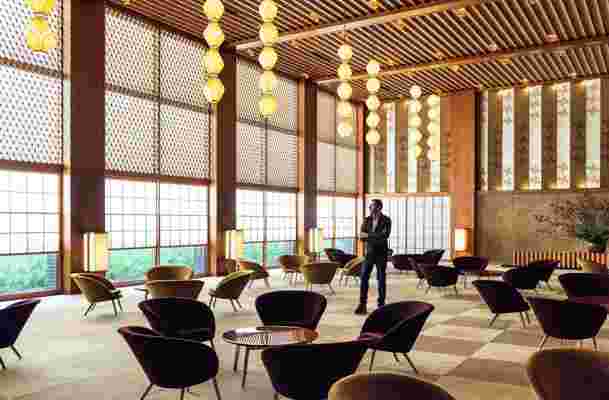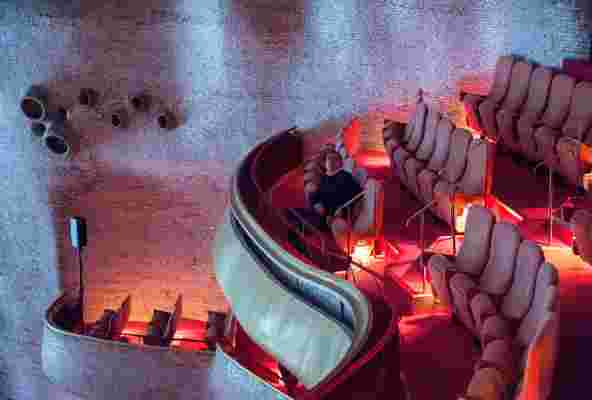On Monday evening the World Monuments Fund (WMF) held their 19th annual Hadrian Gala in the Grand Ballroom of New York’s famed Plaza hotel . The event honored both Tomas Maier, the longtime creative director of Bottega Veneta, and the Stavros Niarchos Foundation—which recently debuted a new Renzo Piano–designed cultural center in Athens . The Foundation received this year’s Hadrian Award, which has been given out since 1988 and spotlights leadership in art and architectural preservation. The late Stavros S. Niarchos, who founded the organization two decades ago, was a fierce advocate for many of Greece’s most treasured buildings.

Tomas Maier and AD100 architect Toshiko Mori at the 19th annual Hadrian Gala at New York’s Plaza Hotel.
Maier, who became Bottega Veneta’s creative director in 2001, was honored with the Watch Award, which celebrates individual activism in the preservation field. In 2014 he kicked off an initiative to raise awareness for Japan’s Modernist landmarks, many of which were threatened or in need of repairs. “Modern sites around the world face persistent threats, and so we’re especially happy that someone like Tomas—who comes from outside the preservation field—uses the power of his prominence to champion these masterpieces,” said Joshua David, WMF’s president and CEO. “Anyone who hears Tomas speak about Japanese Modernism is moved by his passion and driven to be part of the movement to protect and conserve these extraordinary buildings.”
Bringing attention to Tokyo’s iconic Hotel Okura was central to the campaign, which drew other high-profile collaborators, including AD100 architect Toshiko Mori , designer Marc Newson , artist Hiroshi Sugimoto, and the Japanese magazine Casa BRUTUS. The structure’s main wing, which held its honey-hued lobby, was nonetheless lost this past year during a complete overhaul. Toshiko Mori, who is also a close friend of Tomas’s, created the below video for the gala and spoke to AD about the impact of his work and the importance of preserving Japanese Modernist architecture.
AD: Why is Tomas's campaign to raise awareness of Japan’s Modernist architecture especially important to you?
Toshiko Mori: There has not been a large audience who appreciates Japan’s Modernist architecture beyond architectural aficionados, and even within that circle it is quite a small number of people who know the history and stories behind it and appreciates their value and context. It is a very important cultural asset in Japan, yet it is totally undervalued, underappreciated, and people are uninformed about it. In fact, many, many people went to see the Hotel Okura for the first time because of Tomas and Bottega Veneta's campaign.
Someone like Tomas has an ability and power to connect with a larger audience beyond architectural connoisseurs. Since he is someone who defines contemporary taste and sensibilities, people will notice those buildings with a different set of eyes. In general, Japanese people are not the best at appreciating their own cultural assets. Too many things are taken for granted, so when an outsider like Tomas, with an exquisite sensibility, starts to speak about Japanese Modernist architecture, people will start to look and listen.

Maier in the famed lobby of the Hotel Okura, before it was demolished.
AD: What was the impact of losing the main wing of the Hotel Okura?
TM: It is tragic and sad; many people flocked to Hotel Okura in its last days because there were so many memories of weddings, engagements, and celebrations. The Hotel Okura is associated with happy and important events in the lives of Tokyo society for the last 60 years. With the loss of the main wing, significant memories of social history were gone. It literally marked an end of an era.
AD: What are your favorite Modernist Japanese landmarks that are threatened/need to be preserved?
TM: There are too many! Kagawa Prefectural Gymnasium by Kenzo Tange is threatened with demolition in Takamatsu, Kagawa. Yoyogi National Gymnasium, Hotel Tokoen, and Izumo Grand Shrine Cho-no-ya by Kiyonori Kikutake are deteriorating rapidly and built more or less around the same time as the Hotel Okura. The Museum of Modern Art by Junzo Sakakura in Kamakura is in a very precarious state; it is the first modern museum to be built post-World War II.

Maier on the undulating balcony of the 1963 Nissay Theatre, checking out the 20,000 pearl oyster shells that adorn the ceiling.
AD: How has Tomas's campaign influenced preservation in Japan?
TM: A campaign like what Tomas did to try to save Hotel Okura creates a sea of cultural change. While you cannot point to one thing that has had a direct consequence, it influences how people start to embrace Modernist buildings in the stories they tell. I hear more and more about activities on renewing Modernist buildings in Japan as well as organizations, created to save Modernist houses that include large villas, which have been successful in identifying new use or appropriate owners to save them. Maekawa’s Kyoto Kaikan, built in 1960, for instance, was renovated and opened as ROHM Theatre in January 2016 with a café. I think this sensibility of realizing what can be lost through this frenetic "scrap and build" mentality in Japan is slowly but surely seeping through to create a new type of resistance which was not there before.
Video courtesy of Casa Brutus
